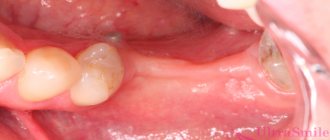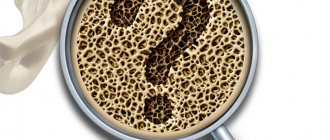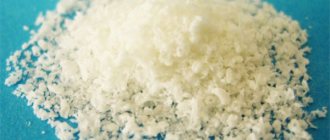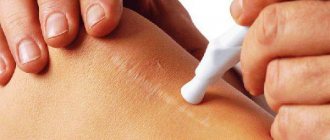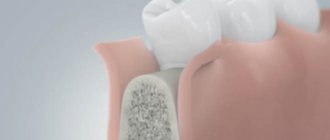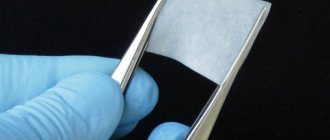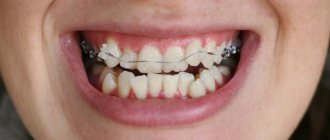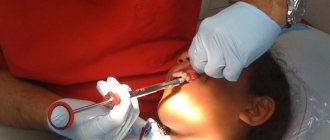Atrophic phenomena in the bone tissue of both jaws occur in every second patient who wishes to restore the dentition by installing dental implants. Performing such an operation in conditions of insufficient volume of the alveolar process becomes impossible. The problem is poor fixation of the structures, which leads to worsening atrophy and destruction of the results of surgical intervention.
Lack of bone tissue in the jaws may be due to the following reasons:
- Surgical tooth extraction;
- Prolonged neglect of treatment for a missing tooth;
- Inflammatory processes in the oral cavity that spread to bone tissue;
- Congenital structural features of the jaws;
- Systemic pathologies of the body affecting the restoration of bone tissue.
It is necessary to combat the resorption of alveolar processes not only for the possibility of dental implantation, but also for the restoration of beautiful facial features that change during the process of significant resorption. The way out of the situation in the presence of bone tissue deficiency is to perform surgical intervention - bone grafting.
General information about bone grafting
Bone grafting is a widespread surgical intervention during which the patient restores the deficiency of the alveolar process in the area required for implantation. Surgery is often performed under local anesthesia with the addition of sedatives, but sometimes general anesthesia is used.
In total, there are 4 main methods of bone grafting, each of which has its own indications. The doctor himself determines which technique for correcting bone deficiency is best suited for the patient. The following types of bone grafting are used in dentistry:
- GTR or directed tissue regeneration (the technique involves the use of grafts that are covered with special collagen membranes that accelerate the regeneration of one’s own bone cells);
- Sinus lifting (surgical intervention on the upper jaw under the bottom of the maxillary sinus, which involves lifting it and correcting the height of the alveolar ridge);
- Splitting of the alveolar process (installation of the graft, essentially, inside the bone, where there are the most favorable conditions for engraftment);
- Replanting a bone block (the technique involves fixing the graft to the patient’s own bone; it is advisable to use autogenous material, since the conditions for engraftment are not the best).
Bone grafting is prescribed only after contraindications to it have been excluded. On average, the operation lasts about an hour or two, after which the patient can be sent home. However, before this, the dentist must write out many recommendations for the recovery period, which will allow you to safely restore the bone and perform dental implantation in the future.
conclusions
Thus, it can be noted that the use of non-resorbable membranes allows one to achieve great results in the field of restoration of jaw bone tissue.
Even with large lesions, large areas of tissue can be restored using a titanium frame.
The procedures performed make it possible to implant dental structures into the strengthened bone.
If you find an error, please select a piece of text and press Ctrl+Enter.
Tags implantation
Did you like the article? stay tuned
Previous article
How can you get a gum burn, and what to do in such a situation?
Next article
Clinical picture of the most common dental pathologies
General recommendations after bone grafting
The patient after bone grafting does not have to stay in the hospital, since the rehabilitation period does not require intensive medical monitoring. However, a person must be extremely attentive to his own condition and, in case of any doubtful symptoms, consult a specialist. In addition, it is important to follow the dentist’s recommendations during the rehabilitation period, which are aimed at preventing complications.
Among the general recommendations after bone grafting, the following points stand out:
- Serious physical activity is prohibited for several weeks after surgery;
- Prolonged exposure to the sun is not recommended, and you should also avoid visiting solariums;
- It is forbidden to go to saunas or baths;
- For a couple of weeks after surgery, you should not smoke or drink alcohol;
- For the first 2-3 days, it is recommended to eat only crushed food at room temperature;
- Do not drink through a straw;
- It is recommended to cough gently and with your mouth open so as not to increase the pressure in the mouth;
- It is better to sleep until the swelling goes down with the head of the bed well raised;
- In the first few weeks after bone grafting, you should avoid flying;
- Diving is prohibited during rehabilitation.
The patient must maintain physical and emotional rest. At first, it is better to refrain from chewing on the operated side. The dentist monitors the patient's condition, monitoring healing during scheduled visits, and also corrects the patient's behavior with the wound.
"Collagen Ultra"
A dietary supplement that is used for treatment and prophylactic purposes to prevent disorders of the musculoskeletal system. The drug is produced in three dosage forms:
- Powder for oral use.
- Gel for external application.
- Glucosamine cream for external use.
As a rule, vitamins are prescribed to improve the functional state of the musculoskeletal system, especially in dystrophic diseases, traumatic disorders and osteoporosis. You can take the drug to strengthen bones and joints after 50 years.
The drug is produced in the form of tablets, which come in two types, of which the red ones contain eleven vitamins, and the blue ones contain eight minerals. There are ten tablets in one blister, forty tablets in total.
Because of riboflavin, the color of urine may acquire a yellow tint; this is safe and should not frighten a person. Patients suffering from diabetes mellitus should take into account that the sugar concentration in one tablet is 0.8 grams, in a daily dosage - 1.6 grams. The drug can be used to strengthen bones in case of fractures.
Oral care after bone grafting
Proper oral hygiene is important in preventing complications and many adverse outcomes. During the rehabilitation period after bone grafting, care of the teeth and the operated area should be thorough and gentle. The main nuances of treating the oral cavity at the recovery stage:
- To clean your teeth, use only a soft toothbrush, and during cleaning you should not touch the operated area for at least several weeks;
- It is prohibited to rinse the mouth with antiseptics, but it is possible to treat some areas with moistened cotton swabs (the area of surgical access, sometimes the area from which the osteoplastic autogenous graft was taken);
- Mechanical damage to the wound surface and sutures is prohibited, which often occurs due to inaccurate treatment of the area;
- Brushing your teeth is recommended after every meal for several days after surgery.
Cleaning the mouth from food debris should be thorough but careful. In the first days after surgery, it is enough to simply provoke bleeding or cause the sutures to diverge.
"Kaltsinova"
A complex product that contains vitamins and minerals. The drug is available in the form of tablets for oral use. "Kaltsinova" comes in four flavors:
The tablets have a round shape. Vitamins are distributed in blisters of nine pieces, there are three in total in the package.
The drug is a complex product, the structure of which includes vitamins and minerals. They are the main elements of metabolic processes. Calcium is involved in the formation of bone tissue, as well as in the contraction of smooth and skeletal muscles, improves the passage of nerve impulses and blood clotting, and brings the functioning of the heart to a stable state. Phosphorus, together with calcium, is involved in the development of teeth and bones, and is also considered an important component of metabolic breakdown processes. "Calcinova" is an excellent drug for strengthening bones in old age.
Vitamin D3 ensures good mineralization of bones and teeth, as well as the absorption of phosphorus and calcium in the gastrointestinal tract and their proper absorption in dental and bone tissues.
Retinol is involved in the formation of various components and ensures the full functioning of the visual organ, as well as the skin and mucous cavities.
Pyridoxine affects the process of hematopoiesis, normalizes the functioning of the central nervous system and helps maintain the structures and functions of the gums, teeth, and bones. Ascorbic acid takes part in the oxidation of some biologically active components and activates the combination of steroid hormones. The substance also regulates carbohydrate metabolism, metabolism in connective tissue, blood clotting and tissue renewal, and normalizes vascular permeability. Vitamin C improves the body's defenses and resistance to infectious diseases, and also reduces the severity of inflammation.
A combined drug that affects phosphorus-calcium metabolism in the body. It is produced in the form of film-coated tablets. The capsules are white in color, biconvex oval in shape, with a notch on one side. "Kalcemin" is produced in bottles made of high-density polyethylene. In total, the package can contain thirty, sixty or one hundred twenty tablets. The drug is suitable for strengthening bones in osteoporosis.
Medicines during the rehabilitation period
The dentist always prescribes a number of medications during the recovery period after bone grafting. Taking them can reduce the risk of infection and relieve unpleasant symptoms that bother people after surgery.
Patients are prescribed:
- Antibacterial agents. The most commonly used group of penicillins, which cope well with infections of the oral cavity and upper respiratory tract. The patient is prescribed a standard seven-day course, which minimizes the risk of an inflammatory process. During this period, you should not drink alcoholic beverages or take medications that suppress the immune system, such as hormonal drugs (prednisolone).
- Antihistamines. Medicines help relieve swelling, which is pronounced in the first days after bone grafting and can cause serious inconvenience to the patient. As a rule, tablet forms of the drug are used, which are used in small dosages.
- Antiseptic solution. In most cases, Chlorhexidine is used. It is used to treat the oral cavity, but not to rinse. It helps fight pathogenic microorganisms in the area of the wound surface.
- Analgesics. Painkillers that help eliminate fairly severe pain during the first days after bone grafting. The drugs are taken exclusively as prescribed by the doctor. For example, the most popular remedy, Ketanov, is taken one tablet at a time with a break between doses of at least 4 hours.
- Healing ointment. Another topical remedy is a special ointment that accelerates tissue regeneration. It is used to ensure that the wound area heals quickly and the patient can return to a full life.
Self-administration of medications is strictly prohibited, as the patient can significantly increase the risk of complications or harm the body as a whole.
Fixation process
Let's look at the main steps for installing a non-absorbable membrane. Most often, the following manipulations occur.
Detachment of the periosteal flap
The doctor must understand that the tissue incision must be carried out in such a way that the fixed membrane does not touch the root part of the tooth.
Otherwise, this can lead to the fact that soft tissues will not recover well, which will facilitate the entry of pathogenic bacteria and the development of inflammatory processes.
A correctly installed membrane will ensure rapid healing and sufficient volume of restored bone tissue. In this case, it is most correct to fix the membrane at a distance of four millimeters from the root.
This means that advanced cases of degradation and destruction of bone tissue cannot be eliminated using targeted tissue regeneration.
When forming flap areas, it is necessary to take into account the specifics of the patient’s soft tissues, as well as the parameters of bone tissue restoration . This will allow you to best select the size of the membrane, as well as increase the effectiveness of therapy.
In general, the success of the manipulation depends on how the incision is made and the flap is formed.
Decortication of the surface of the bed
Decortication measures in the areas where the element will be fixed are carried out with fissures or small spherical burs. Thin drills can also be used.
During the procedure, the specialist must feel the stages of passage of the instrument through the bone tissue. In some cases, it is necessary to preserve individual sections and layers depending on the operating conditions.
The measures are carried out to ensure free movement and access of restorative drugs to the affected area. Also, without this it is impossible to ensure normal blood flow.
Membrane fixation
The structure is fixed on the inconspicuous side with titanium screws. After one side is secured, regenerating drugs are introduced. Then the second side is fixed.
When fixing, it is important to ensure the tightest possible fit. If this is not ensured, soft tissue will begin to grow in the folds, which will reduce the success of the procedure.
Suturing soft tissues
When suturing flaps over membrane elements, it is important to most accurately match the boundaries of the incisions. In this case, when applying sutures, you need to use threads of the smallest thickness.
It is this approach that will protect the operated areas from bacteria and the development of inflammation.
Asepsis
Carrying out disinfection measures is especially important during such operations, since in addition to the external wound, a foreign body is installed inside. Therefore, it is important to provide protection against harmful bacteria.
Normal and complications
The rehabilitation period after bone grafting is accompanied by a number of unpleasant symptoms, which are considered a physiological norm. However, under certain circumstances they can turn into signs of dangerous complications. Since the patient is not under the supervision of a qualified physician, he must be able to distinguish pathology from normality.
Bleeding
Bloody discharge may occur during the rehabilitation period for 2-3 days. They should be quite scanty, that is, just tint the saliva a little. The appearance of blood clots or severe bleeding is a reason to immediately visit a doctor. You can stop the bleeding yourself by pressing the wound surface with your fingers (the skin should be clean, preferably treated with an antiseptic). A damp tea bag stops bleeding well.
Avoiding severe bleeding will help avoid taking non-steroidal anti-inflammatory drugs, in particular acetylsalicylic acid. Some patients are forced to take antiplatelet agents and anticoagulants according to indications. You should be as careful as possible with them, but refusing to take them without the approval of doctors is also prohibited.
Pain
Pain is a concern for all patients who have undergone bone grafting. They should go away completely within the first week after surgery. The pain syndrome gradually decreases and does not have such an impact on a person’s daily life. If there is a worsening of pain or lack of positive dynamics, then you need to consult a doctor and find out the cause of this symptom.
The initial intensity of pain can be completely different. Here, a lot depends not only on the experience of the surgeon, the type of bone grafting, the scope of the operation, but also on the person’s individual pain threshold. On average, the pain is quite intense, but tolerable.
Edema
The introduction of foreign substances, that is, osteoplastic material, as well as tissue damage always leads to the development of edema syndrome. It is most pronounced 2-3 days after surgery, after which it quickly declines. Swelling can be managed by applying ice packs and sleeping on a large pillow with the head elevated.
The swelling goes away by the end of the first week after surgery, otherwise, they talk about a pathological process. This symptom may indicate inflammation of the wound surface or deep-lying structures.
Characteristics of nutrients
Ascorbic acid supports the normal functioning of joint tissue. Its deficiency increases the likelihood of inflammation.
Tocopherol is very beneficial for cartilage fluid. In case of damage, it helps to quickly regenerate joint tissue. Compensating for a lack of vitamin E protects joints from early wear and tear and aging.
Calciferol is responsible for the proper development of the musculoskeletal system. Effective when combined with calcium. If there is a deficiency of vitamin D in a child’s body, there is a high probability of developing rickets. Adult patients with a lack of calciferol are at risk of arthritis, as well as decreased bone density and frequent fractures.
Pyridoxine helps strengthen fibrils. Promotes better absorption of magnesium. Niacin is responsible for the mobility of joints and ligaments. Phylloquinone, responsible for tissue density, reduces the risk of serious damage to the main elements of the musculoskeletal system. Calcium is a guarantor of the proper development of the skeleton, joints and cartilage. The strength of bones and their resistance to mechanical factors depend on its concentration in the body.
Selenium accelerates the processes of restoration of damaged tissues. It is considered a natural pain reliever and helps cope with severe pain when injured or bruised. Silicon improves fibrillar protein structures and increases tissue elasticity. Collagen ensures the strength of the skeletal system. Contained in tendons, bones and cartilage. What drugs can be used to strengthen bones and joints?
The human body constantly needs to replenish its reserves of useful microelements for bones and joints. That is why doctors recommend normalizing your daily diet. If the lack of nutrients is at a high level, it is more correct to use special complexes.
How to deal with complications?
Among the complications that arise during the rehabilitation period, the first place always remains infection of the wound site and internal tissues, for example, the maxillary sinus after sinus lifting. In this situation, the patient notes:
- Severe pain;
- Worsening swelling;
- Redness of the gums;
- The appearance of purulent discharge;
- Temperature increase.
Contact a doctor should be immediate. The dentist immediately sanitizes the oral cavity; sometimes it is necessary to remove sutures and clean the area with bone material. The patient must be prescribed a course of strong antibiotics and anti-inflammatory drugs.
Another unpleasant complication is suture dehiscence. In such a situation, you should immediately go to the clinic, where the dentist will perform new surgical sutures. As a rule, no additional action is required, but in rare cases the graft may become dislodged, which requires almost a second surgical intervention.
Complications associated with rejection of the osteoplastic material or poor fixation of the implants require another bone grafting. Such unfavorable outcomes can be associated not only with medical errors, but also with improper implementation of the dentist’s recommendations. Therefore, the patient is obliged to listen to the doctor’s instructions after bone grafting and strictly follow them.
How to avoid complications?
The development of adverse outcomes after bone grafting is very rare, since modern technologies provide for and eliminate any risks. However, the likelihood of complications is still not zero, and therefore it is worth noting those factors that allow you to avoid them:
- Thorough comprehensive examination of the patient at the preparatory stage;
- Elimination of adjustable risks;
- Planning bone grafting based on the data obtained about the patient;
- Highly qualified and experienced dentist;
- Full compliance with recommendations during the rehabilitation period;
- Use of safe anesthesia drugs and innovative equipment during surgery.
The rehabilitation period is extremely important to obtain good results from surgery. Recommendations after bone grafting must be followed impeccably so that the prognosis fully coincides with reality.
